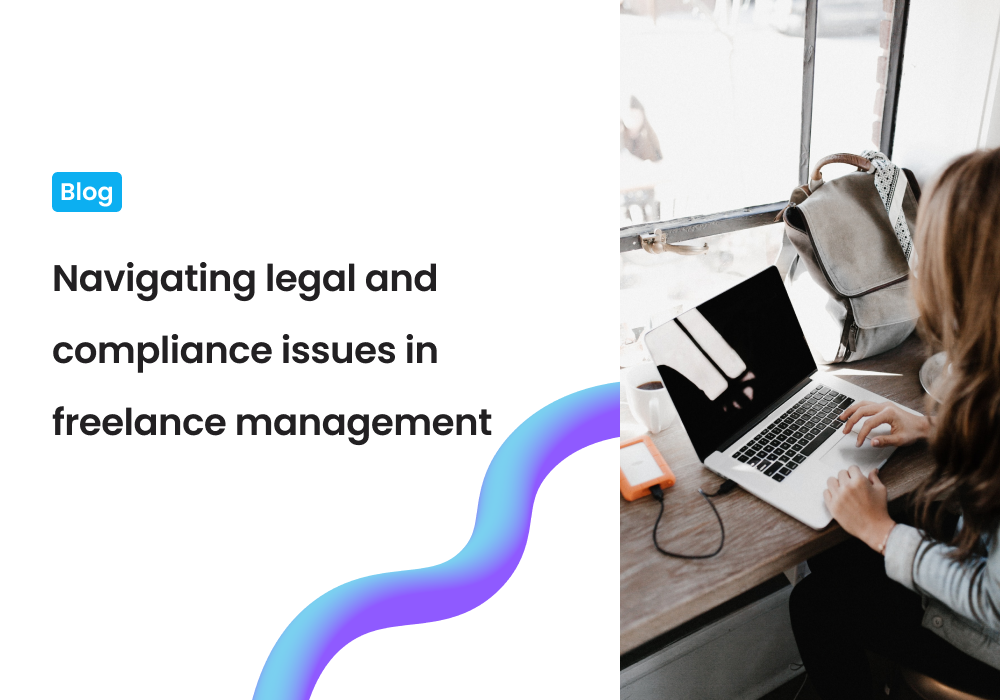With the gig economy on the rise and remote work taking the lead, more and more businesses and staffing agencies have come to rely on freelancers. In fact, one study found that 80% of staffing agencies and companies now rely on freelancers. When you consider a few of the many benefits of this, it’s no wonder the gig economy is booming.
For instance:
-
Freelancers are more likely to be available on the spot to fill a role quickly.
-
Freelancers often boast specialist industry knowledge. This is particularly valuable if you’re looking for new perspectives.
-
Freelancers can be cheaper in the short term than recruiting a permanent staff member. In one specific example, a business can save $17,000+ by hiring a freelance senior software engineer who works at $150 an hour for a one-off project vs. an average of $311,535, including benefits and taxes.
But despite these perks, working with freelancers is uncharted territory for many businesses. With that comes new hurdles- specifically, legal and compliance considerations. Failure to handle these appropriately can sour working relationships with your freelancers - or even land you in legal trouble if you’re not careful.
That’s why in this article, we’re discussing a few of the most significant legal and compliance issues in freelance management and providing some guidance on adhering to these regulations.
Please note: We’re not lawyers. This is just general advice. For specific legal advice for your jurisdiction, please get in touch with a legal professional.
With that said, let’s dive into the nitty-gritty of this blog post!
Independent Contractor Classification
The legal distinction between freelancers and employees can sometimes get muddled. But, seeking a clear and correct classification is essential, as misclassifying an employee as a freelancer can lead to various fines from the IRS or Labor Department in the US. This is no minor issue- 10 to 30% of US employers misclassify employees as independent contractors.
Similarly, in the EU, the misclassification of independent contractors can also result in penalties. Of course, classification rules and penalties vary in each EU state and the UK. However, it’s worth noting that in the EU, around 5.5 million freelancers are incorrectly classified as self-employed. In response, a new 2023 directive likely to be adopted in 2024 will result in many EU freelancers being hired as employees -unless they’re engaged on business-to-business terms, such as being paid a fixed price for their work.
As you probably already know, freelancers, unlike employees, can choose their own working hours, pay rates, and frequently work with multiple clients. But, unlike regular employees, freelancers aren’t entitled to typical employee benefits like sick leave, maternity leave, paid holiday, etc.
To avoid misclassification, it’s wise to categorize workers from the get-go. For example, in the US, this would include asking for a W-9 form upfront to give you the taxpayer information needed to identify a 1099 independent contractor.
In contrast, in the EU, each member state has its own set of regulations on worker classification. For example, in Germany, their tax office (Finanzamt) evaluates professions on a case-by-case basis - and certain professions, such as lawyers, journalists, and accountants, are classified as freelancers.
Using a dedicated freelancer management platform like Bubty is the easiest way to organize and securely store each freelancer's work agreements and legal documentation. It also allows you to customize the onboarding process to automatically request necessary forms whenever you sign on a new contractor. This goes a long way to ensuring that every aspect of onboarding and compliance is standardized and consistent.
Working with International Freelancers
When hiring international freelancers, be aware that their laws might differ. For example, what classifies as a freelancer in your jurisdiction might constitute an employee abroad. That’s why it’s wise to double-check that prospective candidates are classified as freelancers under both jurisdictions. But, again, we suggest visiting your government’s website for further information or employing professional legal advice if you're unsure.
If you’re based in the US, and once you’re confident you’re working with a freelancer located abroad (not an employee), you’ll need them to fill out an IRS Form W-8 to verify their foreign status. In addition, some freelancers may wish to claim tax exemptions if their country of origin has a tax treaty with the US; again, the W-8 form will help them to do that.
In the EU, the rules for verifying a freelancer’s status vary depending on which country you work in. For example, in France, freelancers must register with Usraff (Unions de recouvrement des cotisations de sécurité sociale et d'allocations familiales (Organizations for the Collection of Social Security and Family Benefit Contributions). So, in this example, you might want to check that your French freelancer has undertaken this step.
If you’re based in the US, it’s also vital to have in writing that all work created by a freelancer abroad will be completed outside the US. Otherwise, you’ll be liable for meeting certain conditions. For example, checking their visa and whether they have a right to work for US companies. Failing to check said requirements can lead to fines and penalties.
In contrast, if you’re operating within the EU, and if a freelancer is an EU national (or if they’re a national of a country that has an agreement with the EU, such as Albania, Andorra, and Algeria), they don’t need a work permit to work anywhere within the EU. The EU has an immigration portal where you can check what conditions you need to meet. So be sure to check that out to double-check that you’re ticking all the necessary boxes!
Determining Copyright
The copyright holder is usually whoever created the work. Copyright has to be signed over in writing if you so desire. When working with permanent employees, most employees sign away the copyright to their outputs in their work agreements.
However, with freelancers, you’ll need to establish a “work for hire” agreement to ensure you’re named the copyright holder for the work they produce for you. This needs to clearly state that the contractor isn’t an employee and stipulate the details of the employer, the contractor, the nature of the work being paid for, and a statement of ownership.
Meeting Payment Requirements
Most freelancers operate on a different payment schedule than traditional employees. For example, they might require an upfront payment, followed by installments that coincide with project milestones.
Whatever payment arrangement you make with your freelancers, ensuring you're issued invoices for each payment and that both parties understand the payment plan is essential.
It’s also worth noting that when working with freelancers abroad, it’s worth clarifying how conversion and transaction fees will be handled from the start.
Falling behind on agreed payments presents a legal breach of contract and will likely cause friction between both parties. But, again, this is where a freelance management platform like Bubty can assist. You can set a payment schedule linked to project milestones so everyone knows when payment is due and for what. The platform also lets you pay with one click, avoiding lengthy wait periods! In addition, freelancers can easily upload or generate invoices connected to a project and see at a glance which invoices have already been paid.
Ensuring Sufficient Documentation
We’ve already covered the importance of declaring the copyright holder, setting payment details, and clarifying worker status upfront. But a work agreement should also cover the following:
-
What the work entails: The exact scope, requirements, and milestones
-
When and how freelancers must communicate with your business and vice versa
-
Specific tools to be used during the project (and who provides them)
-
Dispute resolution clauses in case an issue comes up
Best Practices for Minimizing Legal Risks When Working With Freelancers
Now you’re familiar with some of the common legal concerns surrounding freelancer management, here are some excellent best practices to remember to help minimize legal risks:
Avoid Micromanaging Freelancers
Freelancers can set their own hours so long as project milestones are met on time. So, you can’t dictate when or how they complete the work so long as the results meet your requirements.
Treating freelancers the same as permanent employees would raise auditing questions. Your business might even open itself up to legal issues if deadlines are so tight that freelancers have to work full-time hours to meet them. Namely, this might blur the lines between a standard employee's working conditions vs. a freelancer's.
Communicate Throughout
Clear communication between you and your freelancer has to start from the beginning, particularly during the onboarding process. This is the perfect time to iron out any compliance-related issues and ensure that all relevant paperwork is completed.
However, good communication doesn’t stop there. The best way to avoid miscommunication, tension, and disputes is to frequently check in with your freelancer. With a freelancer management solution like Bubty, you can use its in-built communication features like a live chat to keep a conversation going, provide feedback, and request feedback.
As we’ve mentioned, this is especially important during the early stages of your collaboration to ensure all legal and compliance issues are managed and equally imperative in the lead-up to payments and deadlines.
Automate Onboarding to Ensure Compliance
As you may have guessed from the number of times we’ve alluded to it throughout this blog post, many legal and compliance issues come down to insufficient preparation at the start of your working relationship with your freelancer.
That’s why wading through all the necessary compliance-related paperwork during onboarding is vital.
With software like Bubty, you can ensure that form requests, contracts, work handbooks, and other important documents are automatically sent to freelancers at the start of the project. That way, freelancers know exactly what to fill out and what documents to provide. Bubty even lets you and your freelancers sign and store documents within the software, so you can ensure nothing gets lost amidst complicated email threads!
Stay Up To Date with Compliance Law
Don’t get caught off guard by changes in the law. Regularly check for compliance updates to avoid accidentally failing to adhere to new regulations. The simplest way to stay ahead of the curve is to use freelance management software like Bubty, which can help you through compliance classification when hiring someone.
Work With the Same Freelancers Again
One of the easiest ways to minimize legal and compliance-related risks is to use the same pool of freelancers. After all, once you’ve onboarded them once and you have all their documentation in check, it will be much quicker and easier to onboard them again for your next project.
Navigating Legal Challenges When Working With Freelancers Is Easier With Bubty
There’s no shortage of potential legal pitfalls when working with freelancers - especially international ones. But no challenge is insurmountable - especially when you have the right tools. Using an intuitive freelancer management platform makes overseeing all legal documents, payment schedules, and communications easy. This goes a long way to ensuring that legal risks are minimal. If you’re interested in discovering more about such a solution, check out what Bubty offers today!




